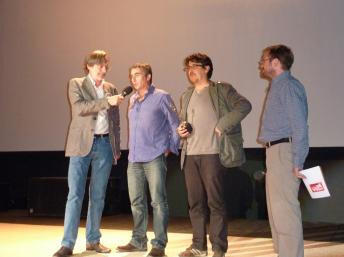SOS photojournalism: web docs to the rescue?
For the second year running at Visa pour l’image, RFI-France 24 awarded an 8,000 euro prize for best web documentary: a new journalistic genre using photos, video and text, and broadcast on internet. As traditional outlets for photojournalists dry up, web documentary-making seems an attractive way forward.
Issued on: Modified:

This year’s prize went to journalist David Dufresne and photographer Philippe Brault for Prison Valley, a report on the prison industry in the United States.
“One out of 100 citizens is imprisoned in the US, a higher percentage even than in China,” says Erin Rosa, an independent journalist featured in Prison Valley. Prison reform activist Christine Donner goes further. “We [Americans] like making money out of people in chains”.
In fact a whole city, Canon City in Colorado, has grown and prospered thanks to its 13 prisons. Sixteen per cent of the town’s population are actually inmates.
Prison Valley, a kind of interactive road movie, takes you right into Canon City itself. After watching each short filmed segment you can get out of the car, as it were, and go deeper into the prison universe through interactive sequences.
So users can check into a room at the motel with a personal Facebook or Twitter account, attend the Dead Warden ceremony run by the Correctional Peace Officers Foundation, visit the prison museum or find out more about the Supermax prison (known as the “Alcatraz of the Rockies”).
Above all, the work invites you to go beyond the film, to take part in online debates and exchange emails with people who appear in the documentary.
“For me, web documentary needs interactivity,” says photographer Philippe Brault.

“In Prison Valley we tried to bring debate into the issue of locking people up. That was the ultimate goal: to set off from a small town in Colorado, surrounded by thirteen prisons, soon to be fourteen, and have that story generate debate.”
He admits to not having a clear idea where they were going at the outset but knew they had a strong story. It was a continual learning curve and took one and a half years to complete.
“We constructed it as we went along, with the [production] team Upian. Even when we were in the field, we were in email contact everyday with them to see whether things were technically possible or not,” says Brault.
The authors made a good choice of subject with Prison Valley, but Brault says not all stories lend themselves to web documentaries.
“You need an unusual story with a significant space/time component, where there’s a past and future, and something contemporary.”
Other stories may simply make good slide shows with sound, he adds.
Their web doc is in three languages, exists as an iPhone application, a TV documentary (it was broadcast on Arte in June) and will shortly be published as a book.
It's proof that multimedia tools really are expanding the different ways we exploit and share information.
Charting a year of change
Ayperi Ecer is thrilled about this trend. As vice-president of pictures at Reuters, she was key to making Times of Crisis – a coproduction between Reuters Image/Mediastorm and which received a special mention in the RFI/France 24 web documentary award.
Times of Crisis charts 365 days of upheaval, beginning with the collapse of Lehman brothers in September 2008.
The story is told through pictures, video, graphics and text, accompanied by an interactive timeline you can dig into to see what was happening on any given day, and the impact it had around the world.
“We think the story of money is the story of our time,” says Ecer. “It’s going to change the way people produce photo stories because you will need to work on issues you’ve never worked on before, and on social classes you’ve never worked on before.
"Generally photography is about victims but when it’s about money, the victims are different.”
The challenge was how to make the subject speak to people while getting facts and figures across. They did this by mixing data with emotional footage.
“How it struck you in Russia, how the Japanese middle class became homeless, how they take your home in California. All these things seem bureaucratic on paper, but figures are things that hit you most in life,” says Ecer.
Good story, who pays?
While these two web docs make gripping viewing and are clearly pushing back the boundaries of what photojournalism can do, there’s currently no viable financial model so it remains to be seen how the new format can take off.
For Times of Crisis, Reuters drew on their own vast archives as a global media agency, a luxury few web documentary producers could afford.
Prison Valley got some 220,000 euros in funding through producer Upian, distributor Arte television and the CNC [French centre for cinema].
Brault says he and Dufresne made around 30,000 euros each.
“We’re not complaining but it took a year and a half, working 15 hours a day, full time. We’ve covered our costs.”
Faced with these financial difficulties, many photographers are reluctant to make the leap. Alain Buu, a freelancer, questions the methods of broadcasting.
“We’re told digital pads are the future of the press, but for technical reasons you can’t download web docs on an iPad,” he says.
Ayperi Ecer admits she has no easy answers about how to make money but since multimedia is the future, so answers will be found.
“I think there will be a real integration between imagery and information on the web because that will ultimately be our newspapers or whatever we happen to call them. Our news will be on the web.”
And beyond the financial questions, Brault says web documentary remains an attractive format.
“The web documentary offers a space for free expression at a time when television is more and more formatted and photography has less and less of a place.”
Daily newsletterReceive essential international news every morning
Subscribe